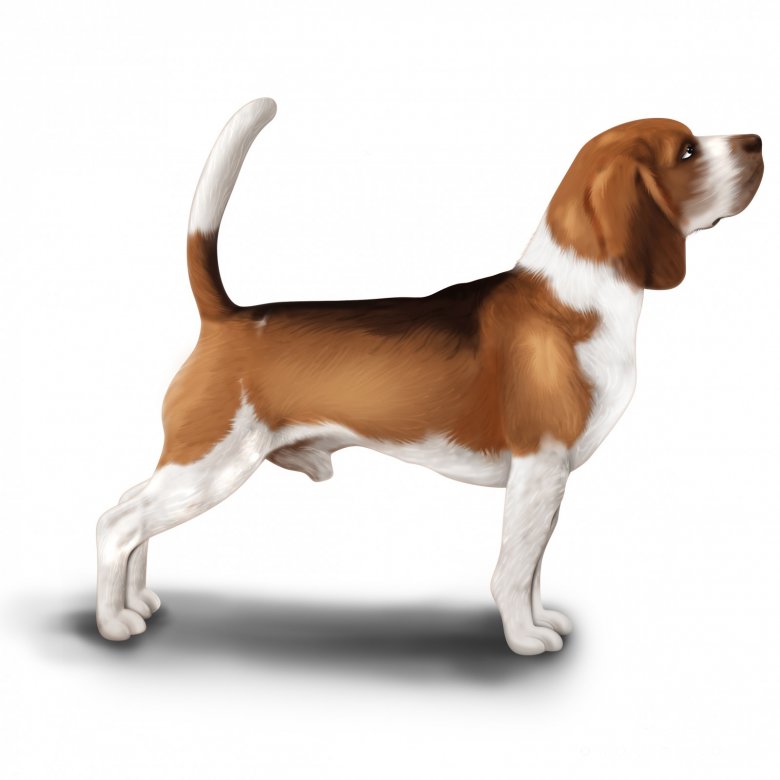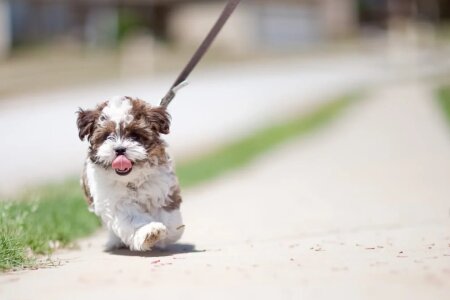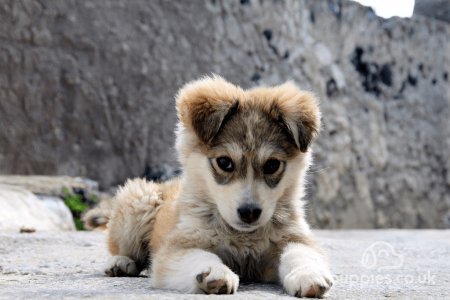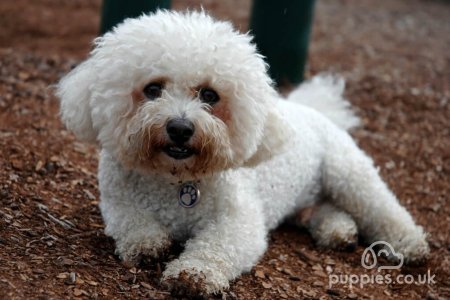Harrier
Overview
A refined, elegant breed native to England, the handsome harrier is an active and playful breed that resembles the English foxhound and has been sometimes referred to as a ‘beagle on steroids.’ These purebred dogs make excellent companions for active families who can provide them with love and plenty of outdoor exercises. Although purebred harriers are working dogs, many are being adopted from shelters here in the UK as house pets. They are classified as working dogs and scent hounds.
Physical Appearance
Harriers have a strong and light build, with well-balanced proportions and a moderately large head. They are a medium-sized breed with an alert and keen expression. Their ears are V-shaped and almost flat, but remain short and set high. Their tails are robust and of medium length and well-carried.
The gait of a harrier in motion is sleek, supple, and steady, with much determination and their nose close to the ground as they move.
Coats of fur for harriers are smooth, in the traditional English style, which is to say it is flat but not too short. Typically, the coat’s colour is predominantly white with secondary shades of black to orange. French variants tend to be tricoloured.
The harrier closely resembles the English foxhound but is noticeably smaller. To the naked eye, harriers are often confused with English foxhounds.
How big do harrier dogs get?
Height: 48-53 cm
Weight: 18-30 kg
Character Traits
The temperament of harriers has evolved over the past seven centuries to be strong-willed and independent, all while having a playful and affectionate side. They were originally bred for hunting, and it is best to not try to deviate from raising them with their natural instincts intact. Although they do not need to be used for hunting purposes today, owners should allow them to follow scents they pick up and to provide them with plenty of mental and physical stimulation.
Harriers are a high energy breed that requires plenty of opportunities to productively use that energy lest they become bored and possibly destructive as a consequence. They must be raised properly and with rigid discipline, although never with a harsh hand.
The harrier has traditionally been bred for hunting, and as a scent hound, he will instinctively have a ‘place in the pack’ so to speak, which is important if other dogs are kept as pets in the home.
Are harrier dogs intelligent? Yes.
Are harrier dogs affectionate? Yes.
Do harrier dogs have high or low energy levels? Very high energy.
Are harrier dogs loyal? Yes, very.
Are harrier dogs playful? Yes, very.
Are harrier dogs aggressive? Never.
Are harrier dogs easy to train? Somewhat, it may be a challenge.
Are harrier dogs good guard dogs? No, but they make for excellent watchdogs.
Ability to Socialise
It is extremely important to socialise harrier puppies well with proper training. Harriers must be welcomed into the home and introduced gradually to family members and other pets, and they must be permitted to find their place in the pack, which instinctively will be the alpha dog around other dogs.
When it comes to socialising a harrier to family, children, and strangers, harriers are very friendly and affectionate and will remain well-behaved provided that they are trained well as puppies.
Harriers are adaptable to many different environments, but they are not the most suitable breed for apartments, urban environments, or small homes. They thrive in larger estates and rural environments where they can roam and play.
Do harrier dogs get along with other pets? Yes, but their hunting instincts may lead them to chase small pets.
Do harrier dogs get along with other dogs? Yes, but they may show dominance.
Are harrier dogs good with kids? Extremely.
Are harrier dogs good with strangers? Yes, extremely.
Lifestyle Suitability
This breed is suitable for owners who are active outdoors and can provide plenty of care for them as they grow from pups into adults. Furthermore, they may pose a challenge for first-time pet owners but are ideal for owners with plenty of experience raising dogs.
Their exercise needs are very high, so it is essential that they are given the opportunity to roam and make use of their instinctual prey drive to run and chase, so long as they are supervised and well-trained.
In public spaces such as parks, harriers should be kept on a lead on account of their willingness to chase. The lead should be taken off at home in the garden or in open outdoor areas where they can roam freely.
Are harrier dogs good for first-time owners? No.
Are harrier dogs hypoallergenic? No.
Are harrier dogs prone to drooling? Not at all.
Are harrier dogs a good breed for apartment living? Not at all.
Do harrier dogs shed a lot? Yes.
Do harrier dogs bark a lot? No, they can be trained to not bark frequently.
Can harrier dogs be left alone at home? Yes, but only for brief periods.
Can harrier dogs handle the heat? Yes.
Can harrier dogs handle cold temperatures? Somewhat.
Are harrier dogs sensitive to loud noises? Yes.
General Health & Health Issues
Generally, harriers are a healthy breed and benefit from being predominantly purebred. Nevertheless, there are still some health issues that prospective owners should be aware of before purchasing or adopting a harrier.
It’s always a good idea to have your harrier checked on a routine basis by your local veterinarian. Even if your harrier appears healthy, veterinarians can diagnose potential health problems early on so that treatment may be more effective.
Some common problems include:
Ear infections: harriers have high set ears, which can accumulate earwax or attract infection rather easily. Inspect your harrier’s ears every week for signs of infection and consult your veterinarian to have the infection treated;
Eye infections: eye conditions are fairly common to harriers, which can range from night-blindness to full blindness if left untreated;
Hypothyroidism: weight gain and lethargy are common symptoms of hypothyroidism in harriers, which can be screened for with a TT4 test from your veterinarian;
Hip dysplasia: sometimes, harriers with a limp gait or lameness in one or more legs could be suffering from hip dysplasia. It can often be treated, but it can develop into arthritis, so it’s best to have your veterinarian perform a health checkup frequently.
How long do harrier dogs live? - 12-15 years
Exercise & Play Time
As a playful breed with high energy levels, harriers require extensive outdoor exercise every day. They were bred as hunting dogs and thrive on being outdoors, especially if permitted to run and chase. Play catch with your harrier and he’ll stay happy and healthy whilst engaging his natural instincts in the process.
At least two hours should be devoted to exercise every day. This could consist of one hour of brisk walking in the morning followed by an hour or more of jogging and playtime in the afternoon or evening.
Harriers should also be permitted to roam and play in a safe private space such as a fenced garden where they can fully use their strong scent to track and chase what they find, provided that they are well supervised.
How much exercise does a harrier dog need? - At least 2 hours per day
Do harrier dogs like water play? Yes, but always maintain supervision.
Nutrition & Feeding
As a hardy hunting breed, harriers work up a large appetite and need to consume a healthy, high-quality diet rich in protein, minerals, and vitamins. Always follow the instructions of your veterinarian when changing their diet and observe your harrier’s feeding routine to ensure that he is eating a healthy quantity.
Are harrier dogs prone to weight gain? Yes.
How much should I feed a harrier puppy? About 270-400g per day, in three sessions.
How much should I feed an adult harrier dog? About 280-420g per day, in total.
Care & Maintenance
The short, thick coats of harriers are fairly easy to maintain and care for. Regular grooming is still essential for caring for their beautiful coats, but especially to detect any possible health problems such as infections.
While harriers are quite independent, they should not be left alone for extended periods of time. Spend plenty of quality time with your companion and he’ll return the affection in kind.
- Grooming: at least once per week, brush down your harrier’s coat of fur and remove any dead hairs. Be sure to keep your home clean since harriers do shed a fair bit, especially during the spring and autumn months.
- Emotional care: try not to leave your harrier alone without any company for longer than a few hours at most. They can become ill-tempered and possibly exhibit destructive behaviour if bored.
History of the Harrier
The harrier dates back to the late 13th century in mediaeval England, although its exact origins are unclear. What is known is that its name owes to its probable first use in breeding which was to hunt hares.
It is possible that the harrier was originally bred from greyhounds and foxhounds, or perhaps bloodhound and basset hounds. Another possible scenario could be that it descended from the English foxhound, a breed that resembles the harrier in many ways today (although English foxhounds are noticeably larger).
Early colonists to America introduced the breed quite early on, and it was recognised formally by the American Kennel Club in 1885. It remains a somewhat rare breed in its native England.
Interesting Facts About Harrier Dogs
From 1851-1971, the Kennel Club in the UK recognised the harrier. It is no longer a recognised breed in the UK.
Harriers are the most popular hunting dogs in Ireland, where they are used to hunt hares and foxes.
Since 2007, it has been illegal to dock the tails of harriers in the UK.
Getting a Harrier Puppy
Harriers are extraordinarily lovely companions with special needs that must be considered before purchasing or adopting. We strongly recommend that prospective owners consult our buying guide before deciding if the choice to own a harrier is right for them. The breeding standards for this breed are well-established even if they are no longer a recognised Kennel Club breed. Should you decide to purchase a harrier, we work with reputable breeders in the UK.
How much does a harrier cost to buy? - About £300-£475.
How much does a harrier cost to feed? - An adult harrier costs about £0.80-£1.40 per day to feed.
How much does insurance for a harrier cost? - About £25-£50 per month.
Sensible alternatives to purchasing a new harrier puppy include rescue and adoption.
Additional resources can be found via harrier registries and associations such as:











